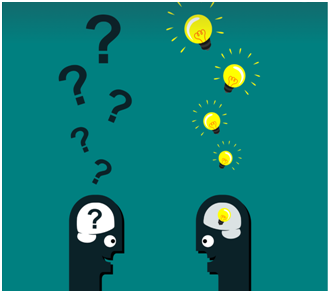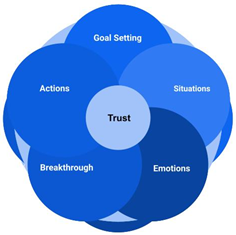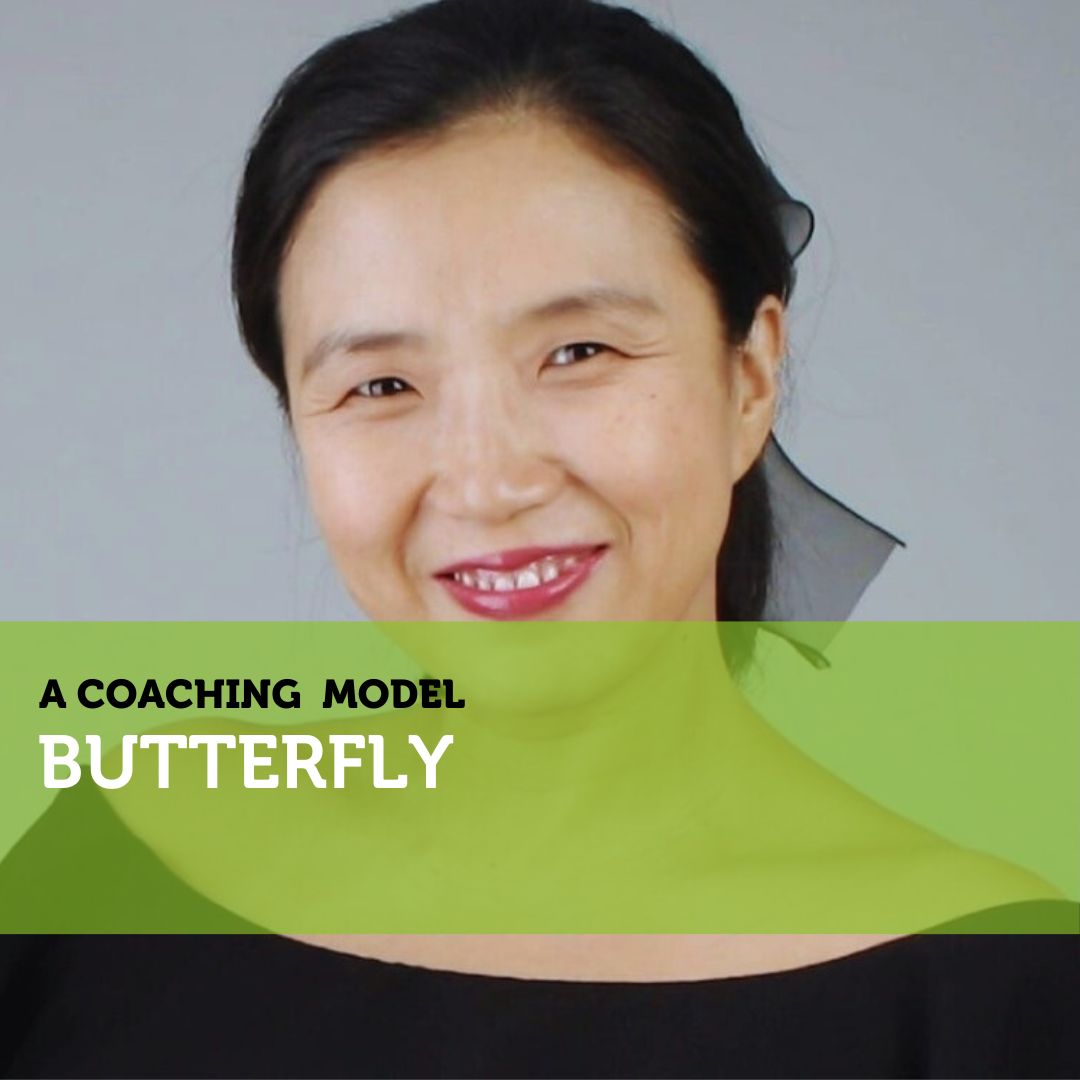A Coaching Model By Eunju Im, Life and Career Coach, AUSTRIA

The BUTTERFLY Symbols
Butterflies symbolize many things in different cultures. Native Americans have considered butterflies as symbols of transformation, hope, and rebirth. In Korea’s traditional culture, The peony – the “king of flowers” – and the butterfly are considered symbols of prosperity and a state of contentment[1].
The BUTTERFLY Coaching Model
Inspired by the symbolism of butterflies, I have developed my butterfly coaching model. In my coaching model, a butterfly represents transformation, hope, and resilience to change, and it also symbolizes lightness and freedom to fly where the clients desire to go. While you are in your comfort zone, like living in a cocoon, you might feel secure, safe, and cozy, and staying in a small cocoon seems to be just as fine. But when you have a dream you want to achieve and you want to grow, life in a cocoon becomes too small and limited. It takes a lot of courage to break your comfortable place in order to move forward with what you want to achieve.
During my ICA journey, sitting in the labs and peer coaching sessions as a client, I was hoping to untangle my problems and express my negative feelings and thoughts. Most of the time, my thinking got clearer my feelings were lighter, and I (re)gained the courage to face my problems and to overcome obstacles with a more positive energy. These are what I have found to be one of the crucial roles as a coach, and that is what I would like to offer to my clients. I want them to feel lighter in their mind through my coaching, and to be courageous to make the real change in their life, and eventually move forward in the direction towards their goal.
The client groups in my model are the people who want transformation in many aspects of their lives (e.g. career, relationship, habit, lifestyle, etc). I intend to serve the clients, in particular in their time of transition (e.g. family moving to new countries for work/study, and people looking for career start/transition). I plan to offer services both in English and Korean, thus I expect that I will offer coaching sessions both in person. I would like to set up my own private practice as well, based in Vienna, Austria. In this coaching model, I have developed six steps aiming at helping the clients on their journey of transformation, as listed below:
1. Trust
Creating trust is the most important step to take as a coach. My coaching model starts with fostering a trusting relationship with the client. How do we do that? I would like to give sufficient time and space to the client in the initial sessions. As a student coach, we have learned that holding space is what a coach needs to do. But do we actually apply this idea fully? Coaches need to keep in mind that when a client does research and reaches out to a coach, this means they feel stuck, heavy, significant, and unable to solve issues by themselves, and need someone to talk to get help. As a coach, we need to respect what it takes for the client to be sitting in front of us. Thus, I would dedicate time in every single session to be fully present with the client and would invite a safe space for the client to open up about their thinking and feelings. I believe that assuring the client and making them feel that they are in a secure space is the beginning of a coaching journey.
2. Desire for Change (Goal Setting)
Once the trust with the client is established, it is time to discuss what the client desires to achieve – their goals. Sometimes the goals can be quite straightforward and the client comes with a clear idea of this. Other times, the client has some ideas, but that might be at the surface level and there might be more to explore underneath. When withdrawing a coaching agreement with the client, defining goals would be necessary to be embedded in the coaching session design. As a coach, I started partnering with my clients to think through a clear and tangible goal that they want to achieve which is transformational and meaningful. If the client agrees, I plan to offer some tools prior to the first session, or after to use the assessment tool for the client to understand the core values, and to assess where the client is feeling and thinking on the topic. Some examples of these tools include the VIA Character Strengths Survey and Wheel of Life to initiate conversations around the client’s values and strengths. The goals will be set through the establishment of a coaching agreement. During the coaching session to set the goal, I will partner with the client to brainstorm and explore goals to be set for the overall coaching contract, to identify the goal that is in line with the client’s vision, beliefs, values, perspective, desires, and significance. The questions should focus on the client, not the situation, to explore what makes the goal important to them. The questions [2]to be asked for the goal setting would be as follows:
- What is important for you about this?
- How will you benefit when you have this?
- What outcome would you like to have moved forward?
- How will you know you achieved what you wanted to accomplish today?
- What will that look like or feel like (subjective or objective)?
During the goal-setting session, it is critical to discuss success measures, so that each subsequent coaching session is designed to meet the goal and success measures and the coach can check the progress against the success measures.
3. Situations
In order to reach the desired goals, it is important to collect evidence and assess the situations the client is facing. What is the current situation like? Up until now, what have you done which worked well? Where does it get in the way of reaching the desired goals? What would the ideal situation look or feel like? These are the questions to be discussed, so this would bring awareness to the client on the reasons for the current situation.
For this part, I plan to offer a tool (e.g. Flip-It) to explore what is happening in the client’s feelings and thinking. Using imaginary tools is a powerful way to evoke awareness, express underlying beliefs, and help the client shift their perspectives. In addition, I can use a tool such as the Cognitive Triangle to facilitate discussions where the client’s feelings, thinking, and behaviors are in to deal with the situations.
4. Emotions
What is more important than situations in the coaching, is the emotions that the client is experiencing. What makes the client feel a certain way? What is the underlying belief the client has? What emotions does the client have to deal with a certain situation? How do these feelings affect the body? What would help the client to take their emotions more positively to reach the goals? Reflecting these questions with the client is a critical point to evoke their awareness, which is the first step of the ‘shift’ of their mind. I will support the client to reflect on their feelings, connect their feelings with the situation, and realize their need for a change of emotions.
Assessment of situations and reflection of emotions would help the client to shift their perspective for change within. The situation would focus more on the outward but the emotions would focus on the inward of the client. As a coach, I will support this through reflection, mirroring, and sharing observations where the client may need further reflection and exploration, hoping to understand what the client is experiencing under the surface.

5. Breakthrough (Direction for Change)
Through steps 1 to 4, the client will be empowered to make a breakthrough, just like cocoons to break through to get out to the light and transform as a butterfly. That breakthrough can only come from the client. It would be the client who will set the direction of change he/she wishes to bring to life. This needs to be a solution-focused approach, a client-based approach, and the coach’s agenda should not block the way. My role as a coach is to partner with the client for their discovery, reframing mindset, and shift of feelings, as well as to acknowledge the shift the client is experiencing and to invite the client to take this new learning forward.
6. Actions
Now, that the coaching process has reached the end part, the last step to be taken is how to solidify these findings to move towards the next steps. I will ask some questions to the client on the actions to be taken to reach the desired goals. The questions would be followed such as:
- What actions do you need to take for this transformation?
- What are the tools, resources, and people to support you?
- What would support you to be accountable?
- What makes you continue to move forward with this change?
- What other areas in your life that this learning can be applied to?
- How would you feel differently with the breakthrough you are experiencing?
This step will help the client to go through workable actions and structures for sustainable and continued change so that this will again allow them to design their actions for their own goal.
In my coaching model, I also developed a diagram to illustrate my aspiration for this model.

Learn How to Create Your Own Coaching Model
Your Coaching Model reflects your values,
philosophies, and beliefs and must communicate who you will coach
and the problems you will solve. Read more about creating your coaching model
References
Butterfly model – try to make sense
[1] Bottle with Peony and Butterfly – GALERIE KOMMOSS | East Asian Art.
[2] ICA Foundation of Coach
